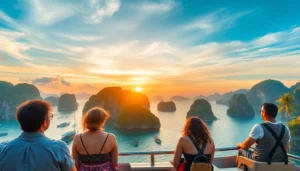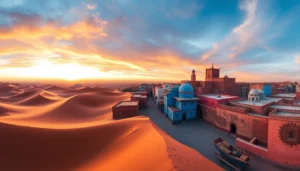Experience the Vibrant Culture and Natural Wonders of Lombok for Your Next Adventure

Introduction to Lombok: Indonesia’s Hidden Gem
Indonesia is an archipelagic nation renowned for its diverse cultural heritage and breathtaking landscapes. Among its numerous islands, Lombok stands out as a captivating destination that seamlessly blends natural beauty, cultural richness, and adventure opportunities. Located in West Nusa Tenggara, Lombok is a lesser-known jewel that offers travelers an authentic Indonesian experience away from the crowded tourist hubs. With its pristine beaches, towering volcanoes, vibrant local traditions, and warm hospitality, Lombok promises a unique travel experience that appeals to adventure seekers, culture enthusiasts, and those seeking tranquility alike.
Geographic Overview and Key Facts
Stretching over approximately 4,700 square kilometers, Lombok is part of the Lesser Sunda Islands, situated just east of Bali across the Lombok Strait. The island’s geography is characterized by dramatic mountain ranges, lush rice terraces, arid savannahs, and a extensive coastline dotted with stunning beaches. The population is approximately 4 million people, predominantly of the Sasak ethnicity, who have preserved their unique language and cultural traditions. The island is divided into several administrative regions, including Lombok Barat (West Lombok), Lombok Tengah (Central Lombok), Lombok Timur (East Lombok), and Lombok Utara (North Lombok). Each region boasts its own distinctive attractions, cultural nuances, and community stories.
Lombok’s strategic location and natural features make it a hub for eco-tourism and outdoor activities. The island’s most prominent geographical feature is Mount Rinjani, Indonesia’s second-highest volcano standing at 3,726 meters, which continues to be an active volcano and a focal point for trekking expeditions. The surrounding waters boast coral reefs and abundant marine biodiversity, attracting divers and snorkelers from around the world. Lombok’s climate is tropical, with a dry season from May to September and a rainy season from October to April, which influences the best times to visit for outdoor activities and beach lounging.
Historical and Cultural Significance of Lombok
Lombok’s history is deeply rooted in its indigenous Sasak culture, which predates the Hindu and Islamic influences that arrived through trade routes. The island’s cultural heritage is characterized by vibrant traditional ceremonies, intricate weaving, and unique musical and dance forms. The Sasak people predominantly adhere to Islam, but the island also retains remnants of older animist traditions, resulting in a distinctive cultural fusion.
Historically, Lombok was part of the Srivijaya empire and later influenced by Hindu-Buddhist kingdoms, which is reflected in archaeological sites and ancient temples. The introduction of Islam in the 17th century transformed the island’s religious landscape, shaping its contemporary cultural identity. In modern times, Lombok has preserved its cultural authenticity through local crafts such as ikat textiles, pottery, and traditional weaving patterns unique to each village or region.
Special cultural events, like the Bau Nyale Festival, exemplify Lombok’s vibrant traditions. During this festival, locals gather to catch sea worms called Nyale, which are believed to be the reincarnation of Princess Mandalika, a legendary figure in Lombok mythology. The festival celebrates folklore, community, and spiritual harmony, attracting both locals and visitors eager to participate in the colorful festivities.
Current Tourism Trends and Visitor Insights
Tourism in Lombok has seen exponential growth over recent years, driven by Indonesia’s increasing global visibility and the island’s unique offerings. While beaches and mountain treks remain the primary attractions, an emerging trend focuses on cultural tourism, eco-tourism, and wellness retreats. Visitors increasingly seek authentic experiences that connect them with local traditions and natural environments.
According to recent surveys and tourism data, the majority of visitors are from neighboring Southeast Asian countries, Australia, and Europe. Adventure tourism, including trekking Mount Rinjani and exploring underwater reefs, remains highly popular. Meanwhile, luxury travelers are drawn to boutique resorts and wellness centers nestled amidst scenic landscapes.
Traveler feedback highlights the desire for sustainable tourism practices—preserving the environment and supporting local communities. Initiatives such as community-based tourism programs and eco-lodges are gaining momentum, reflecting a global shift towards more responsible travel. Furthermore, social media has played a significant role in showcasing Lombok’s hidden spots and lesser-known villages, fueling curiosity and repeat visits among explorers eager to uncover authentic facets of the island.
Top Attractions and Natural Landscapes in Lombok
Iconic Beaches and Surfing Spots
Lombok’s coastline is renowned for its pristine, white-sand beaches and world-class surf breaks. Kuta Beach in the south is arguably the most famous, offering ideal waves for both beginners and seasoned surfers. Pantai Tanjung Aan, with its turquoise waters and soft sands, is perfect for relaxation and beach activities. Gili Trawangan, part of the Gili Islands off the northwest coast, is famous for lively nightlife and vibrant marine life, making it a favorite among backpackers and divers.
Other notable beaches include Pantai Selong Belanak, with its gentle surf suitable for beginners, and Mawun Beach, known for its tranquil ambiance and scenic views. These beaches are not only havens for water sports but also excellent spots for sunset viewing, picnicking, and cultural events on the shoreline.
Majestic Mount Rinjani and Trekking Adventures
Mount Rinjani stands as a symbol of Lombok’s rugged beauty and adventurous spirit. Trekking to the summit is a challenging yet rewarding experience, with routes that typically take 2–3 days. The trek offers unparalleled views of crater lakes, hot springs, and panoramic vistas of the island. Along the way, trekkers pass through lush forests, bamboo groves, and native Sasak villages, providing opportunities to learn about local traditions and lifestyles.
Guided expeditions emphasize safety and environmental consciousness, encouraging responsible tourism. Rinjani’s crater lake, Segara Anak, is a highlight, boasting striking blue waters and opportunities for boating and photography. The volcanic landscape presents unique geological features, including volcanic cones and sulfur deposits, making it a must-visit for geology enthusiasts.
Hidden Waterfalls and Eco-Reserves
Lombok is bursting with waterfalls hidden amidst its tropical forests—an emerging eco-tourism niche. Notable among them are Sendang Gile and Tiu Kelep waterfalls near Mount Rinjani, accessible via trekking routes with well-maintained trails. These waterfalls offer refreshing swimming spots and photogenic cascades that attract nature lovers and adventure tourists alike.
Additional lesser-known waterfalls, such as Benang Stokel and Benang Kelambu, provide quieter, scenic retreats away from crowded tourist spots. Lombok also boasts several eco-reserves and marine protected areas like the Gili Islands’ marine parks, where snorkelers can observe vibrant coral reefs and diverse marine ecosystems.
Such natural attractions promote eco-friendly tourism practices, conservation awareness, and regional sustainable development efforts.
Authentic Cultural Experiences in Lombok
Traditional Sasak Villages and Crafts
Immersing in Lombok’s local culture is best experienced through visits to traditional Sasak villages like Sade and Sukarara. These villages offer a glimpse into the daily life, architecture, and craftmanship of the indigenous people. Visitors can observe weaving techniques used to produce the distinctive ikat textiles, which are integral to Sasak cultural identity.
Handmade crafts, such as pottery, carved bamboo, and beadwork, provide opportunities to engage with artisans and purchase authentic souvenirs. Home-stay programs and cultural workshops further deepen understanding, allowing travelers to participate in traditional farming, cooking, or craft-making activities.
Local Cuisine and Culinary Delights
Lombok’s food reflects its rich cultural tapestry, featuring a blend of savory, spicy, and sweet flavors. Signature dishes include Ayam Taliwang, spicy grilled chicken marinated with chili, garlic, and lime, and Plecing Kangkung, a flavorful vegetable salad. Seafood is abundant, with fresh grilled fish, prawns, and calamari served with aromatic rice and sambal.
Night markets and warungs (local eateries) are excellent venues to savor authentic Lombok cuisine. Traditional snack offerings include crispy tempura-like crackers, kuih (sweet rice cakes), and palm sugar-based desserts. Participating in local food festivals or cooking classes can enrich visitors’ appreciation of Lombok’s culinary heritage.
Festivals, Music, and Cultural Events
Festivals like the Bau Nyale Festival highlight Lombok’s vibrant cultural calendar. During this event, communities gather along coastal areas to catch sea worms, symbolizing fertility and prosperity. The festival involves traditional music, dance, and colorful parades, creating a lively, communal atmosphere.
Music and dance performances, such as Gendang Beleq (large drum performances), showcase the island’s musical heritage. Arts and crafts fairs are common during major celebrations, providing platforms for artisans to display their work. Participating in these cultural events allows visitors to connect deeply with Lombok’s community spirit and traditional values.
Planning Your Trip: Tips and Practical Guides
Best Seasons and Timing for Visiting Lombok
The optimal time to visit Lombok is during its dry season, from May to September, when weather conditions favor outdoor excursions, beach activities, and trekking. July and August are peak months, coinciding with school holidays and festival seasons, thus requiring early bookings. The rainy season (October to April) brings lush landscapes but also higher humidity and occasional storms, which can disrupt outdoor plans.
Planning ahead for seasonal festivals, local events, and environmental conditions helps maximize your experience. Shoulder months like April and October offer a balance of favorable weather and fewer crowds.
Travel Arrangements and Local Transportation
Most travelers arrive via Lombok International Airport, with direct flights from major Indonesian hubs and neighboring countries. Once on the island, transportation options include rental motorbikes, private drivers, and organized tours. For exploring remote beaches or hiking trails, renting a scooter is a popular choice, but safety precautions are essential.
Public transportation is limited, so advance planning or using local travel services is recommended. The availability of shuttle services, car rentals, and boat transfers to the Gili Islands enhances connectivity for travelers seeking exploration beyond the main island.
Accommodation Options and Budget Planning
Lombok offers diverse lodging options ranging from luxury resorts and boutique hotels to budget hostels and guesthouses. In popular areas like Senggigi, Kuta, and Gili Trawangan, international-standard resorts provide comprehensive amenities, spa services, and fine dining. Budget travelers can find comfortable hostels offering communal spaces and local homestays that immerse guests in the community.
Prices vary seasonally, with peak months demanding early reservations and premium rates. Planning your accommodation based on your itinerary, preferred comfort level, and budget ensures a smooth experience. Package deals, travel agents, and online booking platforms facilitate convenient arrangements.
Conclusion: Why Lombok Should Be Your Next Destination
Summary of Unique Attractions and Experiences
Lombok stands out as a richly diverse island offering unparalleled natural beauty, vibrant culture, and adventure opportunities. From the towering Rinjani volcano to serene beaches, hidden waterfalls, and authentic Sasak villages, Lombok combines the best of Indonesia’s tradition and wilderness. Its growing reputation as an eco-friendly, sustainable tourism destination makes it ideal for conscientious travelers seeking meaningful experiences.
Inspiring Stories from Visitors
Many visitors recount transformative journeys on Lombok—trekking to Rinjani’s summit, diving amid vibrant reefs, participating in local festivals, and engaging with warm communities. Tourists often highlight the island’s genuine hospitality and untouched charm, making Lombok a memorable and enriching vacation choice.
Getting Started with Your Lombok Journey
Embarking on a trip to Lombok requires careful planning—considering the best travel seasons, selecting appropriate accommodations, and mapping out desired activities. With proper preparation, visitors can uncover Lombok’s hidden treasures, immerse themselves in local culture, and create lifetime memories. Whether seeking adventure, cultural authenticity, or relaxation, Lombok beckons as Indonesia’s perfect escape — a destination that promises discovery at every turn.





